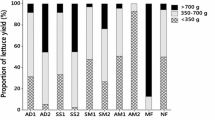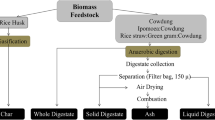Abstract
Meat and bone meal (MBM) is a byproduct of the rendering industry and is considered an excellent potential organic fertilizer due to its balanced availability of nutrients. However, rapid nutrient mineralization of the MBM that is less synchronized with crop demand, could lead to significant nutrient losses, necessitating measures to modify the mineralization rates of MBM. Here we tested the influence of two natural nitrification inhibitors (NIs; neem cake and karanja cake) on the mineralization of carbon (C), nitrogen (N), and phosphorus (P) from MBM, the associated soil potential enzymatic activity, microbial abundance and broad composition and the influence of these process on plant growth. MBM mineralized quickly, with 35% mineralization of the applied N within the first 5 days of incubation. NIs reduced nitrification rate of MBM by ~ 40% and increased the retention of NH4+ (~ 35%) in soil compared with MBM only. Soil CO2 respiration, potential enzymatic activity and microbial abundance were similar in the MBM with and without NIs, suggesting a low negative effect of NIs on the microbial growth and functionality. MBM exhibits a slow P mineralization rate, with an increase in soil available P was observed only at later sampling points (36 days after incubation) with solubilization of a fraction of Ca-P. P mineralization rates were similar between the MBM with and without NIs. MBM with and without NIs was equally effective in maintaining the plant growth and biomass, which were similar to inorganic fertilizers. Our study suggests that MBM blended with NIs could increase the crop nutrient use efficiency via lowering N losses, while improving soil microbiological health.






Similar content being viewed by others
References
Abbasi MK, Adams WA (2000) Estimation of simultaneous nitrification and denitrification in grassland soil associated with urea-N using 15 N and nitrification inhibitor. Biol Fertil Soils 31:38–44
Abbasi MK, Hina M, Tahir MM (2011) Effect of Azadirachta indica (neem), sodium thiosulphate and calcium chloride on changes in nitrogen transformations and inhibition of nitrification in soil incubated under laboratory conditions. Chemosphere 82:1629–1635. https://doi.org/10.1016/j.chemosphere.2010.11.044
Acosta-Martinez V, Tabatabai MA (2011) Phosphorus cycle enzymes. In: Dick RP (ed) Methods of soil enzymology. Soil Science Society of America, Madison, WI, pp 247–273
Becker GS (2004) Animal rendering: economics and policy. Congressional research service report for congress. Order code RS21771
Bengtsson G, Bengtson P, Månsson KF (2003) Gross nitrogen mineralization, immobilization, and nitrification rates as a function of soil C/N ratio and microbial activity. Soil Biol Biochem 35:143–154. https://doi.org/10.1016/S0038-0717(02)00248-1
Berg P, Rosswall T (1985) Ammonium oxidizer numbers, potential and actual oxidation rates in two Swedish arable soils. Biol Fertil Soils 1:131–140
Biswas K, Chattopadhyay I, Banerjee RK, Bandyopadhyay U (2002) Biological activities and medicinal properties of neem (Azadirachta indica). Curr Sci 82:1336–1345
Brooks PD, Stark JM, McInteer BB, Preston T (1989) Diffusion method to prepare soil extracts for automated nitrogen-15 analysis. Soil Sci Soc Am J 53:1707–1711. https://doi.org/10.2136/sssaj1989.03615995005300060016x
Cayuela ML, Sinicco T, Mondini C (2009) Mineralization dynamics and biochemical properties during initial decomposition of plant and animal residues in soil. Appl Soil Ecol 41:118–127. https://doi.org/10.1016/j.apsoil.2008.10.001
Dahiya DJ, Kumar R, Phogat V, Narwal RP (2009) Role of neem in increasing nitrogen use efficiency. Neem, a Treatise 434
Damon PM, Bowden B, Rose T, Rengel Z (2014) Crop residue contributions to phosphorus pools in agricultural soils: a review. Soil Biol Biochem 74:127–137. https://doi.org/10.1016/j.soilbio.2014.03.003
Dancer WS, Peterson LA, Chesters G (1973) Ammonification and nitrification of N as influenced by soil pH and previous N treatments. Soil Sci Soc Am J 37:67–69. https://doi.org/10.2136/sssaj1973.03615995003700010024x
Dechorgnat J, Nguyen CT, Armengaud P, Jossier M, Diatloff E, Filleur S, Daniel-Vedele F (2011) From the soil to the seeds: the long journey of nitrate in plants. J Exp Bot 62:1349–1359. https://doi.org/10.1093/jxb/erq409
European Commission (2000) Council Decision (EC) N. 2000/766 of 4 December 2000 concerning certain protection measures with regard to transmissible spongiform encephalopathies and the feeding of animal protein. Official Journal of the European Communities 07.12.2000 (L 306/32)
Fierer N, Schimel JP, Holden PA (2003) Variations in microbial community composition through two soil depth profiles. Soil Biol Biochem 35:167–176. https://doi.org/10.1016/S0038-0717(02)00251-1
Frankenberger WT Jr, Johanson JB (1982) Effect of pH on enzyme stability in soils. Soil Biol Biochem 14:433–437. https://doi.org/10.1016/0038-0717(82)90101-8
Fraterrigo JM, Balser TC, Turner MG (2006) Microbial community variation and its relationship with nitrogen mineralization in historically altered forests. Ecol 87:570–579. https://doi.org/10.1890/05-0638
Geurts JJ, Smolders AJ, Banach AM, van de Graaf JP, Roelofs JG, Lamers LP (2010) The interaction between decomposition, net N and P mineralization and their mobilization to the surface water in fens. Water Res 44:3487–3495. https://doi.org/10.1016/j.watres.2010.03.030
Gooding CH (2012) Data for the carbon foot printing of rendering operations. J Ind Ecol 16:223–230. https://doi.org/10.1111/j.1530-9290.2011.00430.x
Grennfelt P, Hultberg H (1986) Effects of nitrogen deposition on the acidification of terrestrial and aquatic ecosystems. Water Air Soil Pollut 30:945–963
Jeng AS, Vagstad N (2009) Potential nitrogen and phosphorus leaching from soils fertilized with meat and bone meal. Acta Agric Scand Sect B Soil Plant Sci 59:238–245. https://doi.org/10.1080/09064710802024164
Jeng AS, Haraldsen TK, Grønlund A, Pedersen PA (2007) Meat and bone meal as nitrogen and phosphorus fertilizer to cereals and rye grass. In: Advances in integrated soil fertility management in sub-Saharan Africa: challenges and opportunities. Springer, Dordrecht, pp 245–253
Kaiserli A, Voutsa D, Samara C (2002) Phosphorus fractionation in lake sediments–lakes Volvi and Koronia, N. Greece. Chemosphere 46:1147–1155. https://doi.org/10.1016/S0045-6535(01)00242-9
Khalil MI, Hossain MB, Schmidhalter U (2005) Carbon and nitrogen mineralization in different upland soils of the subtropics treated with organic materials. Soil Biol Biochem 37:1507–1518. https://doi.org/10.1016/j.soilbio.2005.01.014
Khalil MI, Gutser R, Schmidhalter U (2009) Effects of urease and nitrification inhibitors added to urea on nitrous oxide emissions from a loess soil. J Plant Nutr Soil Sci 172:651–660. https://doi.org/10.1002/jpln.200800197
Kumar R, Devakumar C, Sharma V, Kakkar G, Kumar D, Panneerselvam P (2007) Influence of physicochemical parameters of neem (Azadirachta indica A Juss) oils on nitrification inhibition in soil. J Agric Food Chem 55:1389–1393. https://doi.org/10.1021/jf0632177
Landi L, Renella G, Giagnoni L, Nannipieri P (2011) Activities of proteolytic enzymes. In: Dick RP (ed) Methods of soil enzymology. Soil Science Society of America, Madison, WI, pp 247–273
Majumdar D (2002) Suppression of nitrification and N2O emission by karanjin-a nitrification inhibitor prepared from karanja (Pongamia glabra Vent.). Chemosphere 47:845–850. https://doi.org/10.1016/S0045-6535(01)00287-9
Majumdar D (2008) Unexploited botanical nitrification inhibitors prepared from karanja plant. Natural Product Radiance 7:58–67 http://hdl.handle.net/123456789/5647
Martens-Habbena W, Berube PM, Urakawa H, José R, Stahl DA (2009) Ammonia oxidation kinetics determine niche separation of nitrifying Archaea and Bacteria. Nature 461:976–979. https://doi.org/10.1038/nature08465
McCarty GW (1999) Modes of action of nitrification inhibitors. Biol Fertil Soils 29:1–9. https://doi.org/10.1007/s003740050
Melero S, Porras JCR, Herencia JF, Madejon E (2006) Chemical and biochemical properties in a silty loam soil under conventional and organic management. Soil Tillage Res 90:162–170. https://doi.org/10.1016/j.still.2005.08.016
Möller K, Oberson A, Bünemann EK, Cooper J, Friedel JK, Glaesner N, Hortenhuber S, Lose A, Mader P, Meyer G, Muller T, Symanczik S, Weissengruber L, Wollmann I, Magid J (2018) Improved phosphorus recycling in organic farming: navigating between constraints. Adv Agron 147:159–237. https://doi.org/10.1016/bs.agron.2017.10.004
Mondini C, Cayuela ML, Sinicco T, Sánchez-Monedero MA, Bertolone E, Bardi L (2008) Soil application of meat and bone meal. Short-term effects on mineralization dynamics and soil biochemical and microbiological properties. Soil Biol Biochem 40:462–474. https://doi.org/10.1016/j.soilbio.2007.09.010
Moody PW, Aitken RL (1997) Soil acidification under some tropical agricultural systems. 1. Rates of acidification and contributing factors. Soil Res 35:163–174. https://doi.org/10.1071/S96069
Nogalska A, Skwierawska M, Nogalski Z, Kaszuba M (2013) The effect of increasing doses of meat and bone meal (MBM) applied every second year on maize grown for grain. Chilean J Agric Res 73:430–434. https://doi.org/10.4067/S0718-58392013000400015
Nogalska A, Chen L, Sienkiewicz S, Nogalski Z (2014) Meat and bone meal as nitrogen and phosphorus supplier to cereals and oilseed rape. Agric Food Sci 23:19–27. https://doi.org/10.23986/afsci.8841
Quideau SA, McIntosh AC, Norris CE, Lloret E, Swallow MJ, Hannam K (2016) Extraction and analysis of microbial phospholipid fatty acids in soils. J Vis Exp 114:e54360. https://doi.org/10.3791/54360
Rochester I, Constable G, Saffigna P (1996) Effective nitrification inhibitors may improve fertilizer recovery in irrigated cotton. Biol Fertil Soils 23:1–6. https://doi.org/10.1007/bf00335810
Rochette P, Angers DA, Chantigny MH, MacDonald JD, Bissonnette N, Bertrand N (2009) Ammonia volatilization following surface application of urea to tilled and no-till soils: a laboratory comparison. Soil Tillage Res 103:310–315. https://doi.org/10.1016/j.still.2008.10.028
Ruban V, López-Sánchez JF, Pardo P, Rauret G, Muntau H, Quevauviller P (2001) Harmonized protocol and certified reference material for the determination of extractable contents of phosphorus in freshwater sediments–a synthesis of recent works. Fresenius J Anal Chem 370:224–228. https://doi.org/10.1007/s002160100
Sahrawat KL (1982) Comparative evaluation of karanjin and extracts of karanja (Pongamia glabra Vent.) and neem (Azadirachta indica L.) seeds for retardation of nitrification of urea in soil. J Indian Soc Soil Sci 30:156–159
Santhi SR, Palaniappan SP, Purushothaman D (1986) Influence of neem leaf on nitrification in a lowland rice soil. Plant Soil 93:133–135. https://doi.org/10.2307/42936269
Shen J, Yuan L, Zhang J, Li H, Bai Z, Chen X, Zhang F (2011) Phosphorus dynamics: from soil to plant. Plant Physiol 156:997–1005. https://doi.org/10.1104/pp.111.175232
Singh S, Shivay YS (2003) Coating of prilled urea with ecofriendly neem (Azadirachta indica A. Juss.) formulations for efficient nitrogen use in hybrid rice. Acta Agron Hung 51:53–59. https://doi.org/10.1556/AAgr.51.2003.1.7
Taylor JP, Wilson B, Mills MS, Burns RG (2002) Comparison of microbial numbers and enzymatic activities in surface soils and subsoils using various techniques. Soil Biol Biochem 34:387–401. https://doi.org/10.1016/S0038-0717(01)00199-7
Van-Camp L, Bujarrabal B, Gentile AR, Jones RJ, Montanarella L, Olazabal C, Selvaradjou SK (2004) Reports of the technical working groups established under the thematic strategy for soil protection. EUR 21319 EN/3. Office for official publications of the European communities, Luxembourg
Zaman MDHJ, Di HJ, Cameron KC, Frampton CM (1999) Gross nitrogen mineralization and nitrification rates and their relationships to enzyme activities and the soil microbial biomass in soils treated with dairy shed effluent and ammonium fertilizer at different water potentials. Biol Fertil Soils 29:178–186. https://doi.org/10.1007/s003740050
Zhao W, Cai ZC, Xu ZH (2007) Does ammonium-based N addition influence nitrification and acidification in humid subtropical soils of China? Plant Soil 297:213–221. https://doi.org/10.1007/s11104-007-9334-1
Acknowledgements
We would like to thank Kyungjin Min for her feedback on the earlier version of manuscript.
Funding
This research project was funded by the United States Department of Agriculture (USDA NIFA award: 2016-67020-25264).
Author information
Authors and Affiliations
Corresponding author
Additional information
Publisher’s note
Springer Nature remains neutral with regard to jurisdictional claims in published maps and institutional affiliations.
Electronic supplementary material
ESM 1
(DOCX 538 kb)
Rights and permissions
About this article
Cite this article
Jatana, B.S., Kitchens, C., Ray, C. et al. Regulating the nutrient release rates from proteinaceous agricultural byproducts using organic amendments and its effect on soil chemical and microbiological properties. Biol Fertil Soils 56, 747–758 (2020). https://doi.org/10.1007/s00374-020-01446-z
Received:
Revised:
Accepted:
Published:
Issue Date:
DOI: https://doi.org/10.1007/s00374-020-01446-z




